Public Health: Leadership, Advocacy, and Alcohol Advertising Removal
VerifiedAdded on 2023/06/03
|16
|4314
|59
Report
AI Summary
This assignment provides a comprehensive overview of public health, focusing on the crucial roles of leadership and advocacy. It differentiates between leadership and management, highlighting the importance of public health advocacy in improving community health and protecting individual health rights. The assignment also contrasts lobbying and advocacy, emphasizing the importance of evaluating advocacy strategies for effectiveness and sustainability. Furthermore, it presents a case study involving the McCusker Centre for Action on Alcohol and Youth, outlining strategies for removing alcohol-based advertisements from television during live Australian sports events. It discusses potential impacts on team dynamics and work outcomes, the key elements of an action plan, and individual strategies for reducing alcohol consumption among young people. Desklib offers a platform to access this and many more solved assignments.
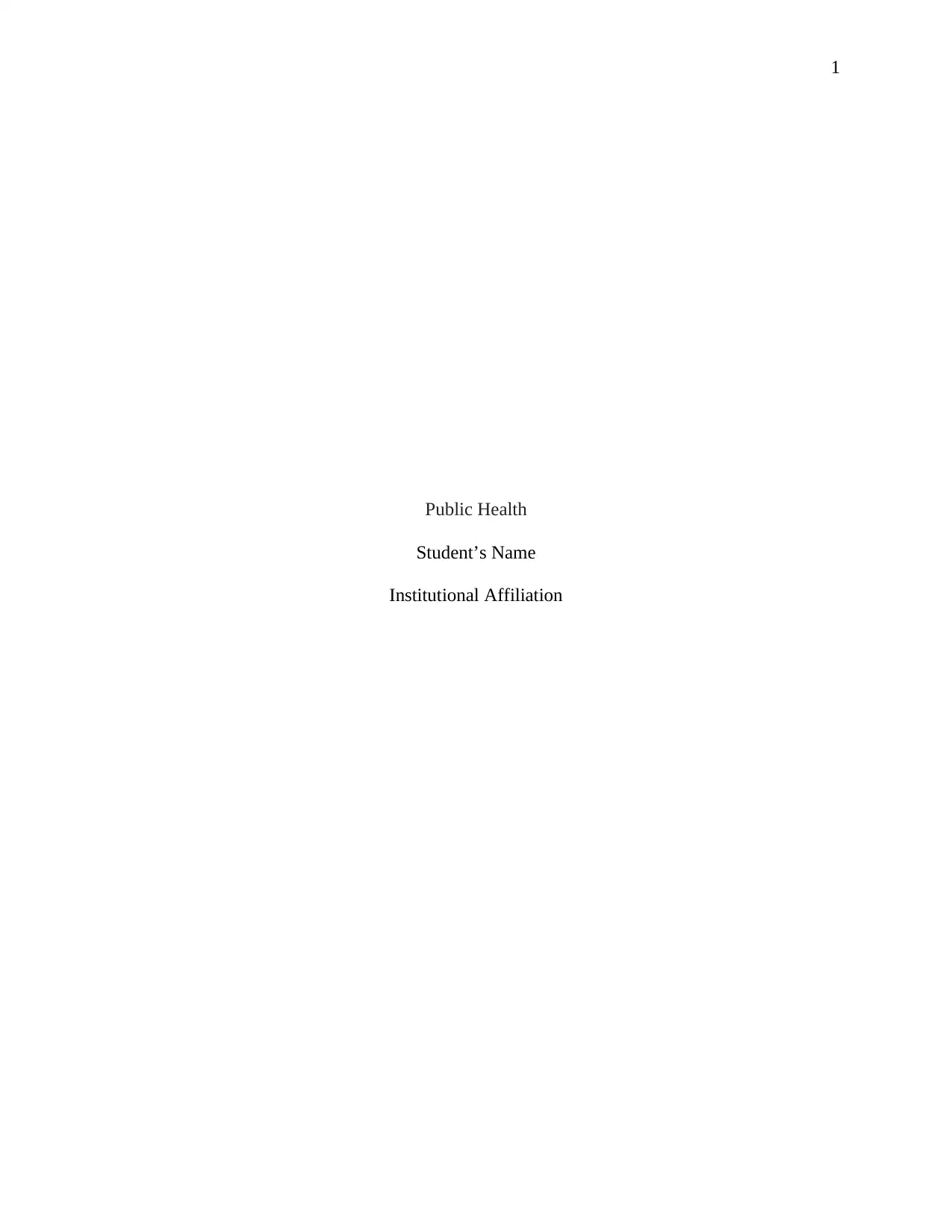
1
Public Health
Student’s Name
Institutional Affiliation
Public Health
Student’s Name
Institutional Affiliation
Paraphrase This Document
Need a fresh take? Get an instant paraphrase of this document with our AI Paraphraser
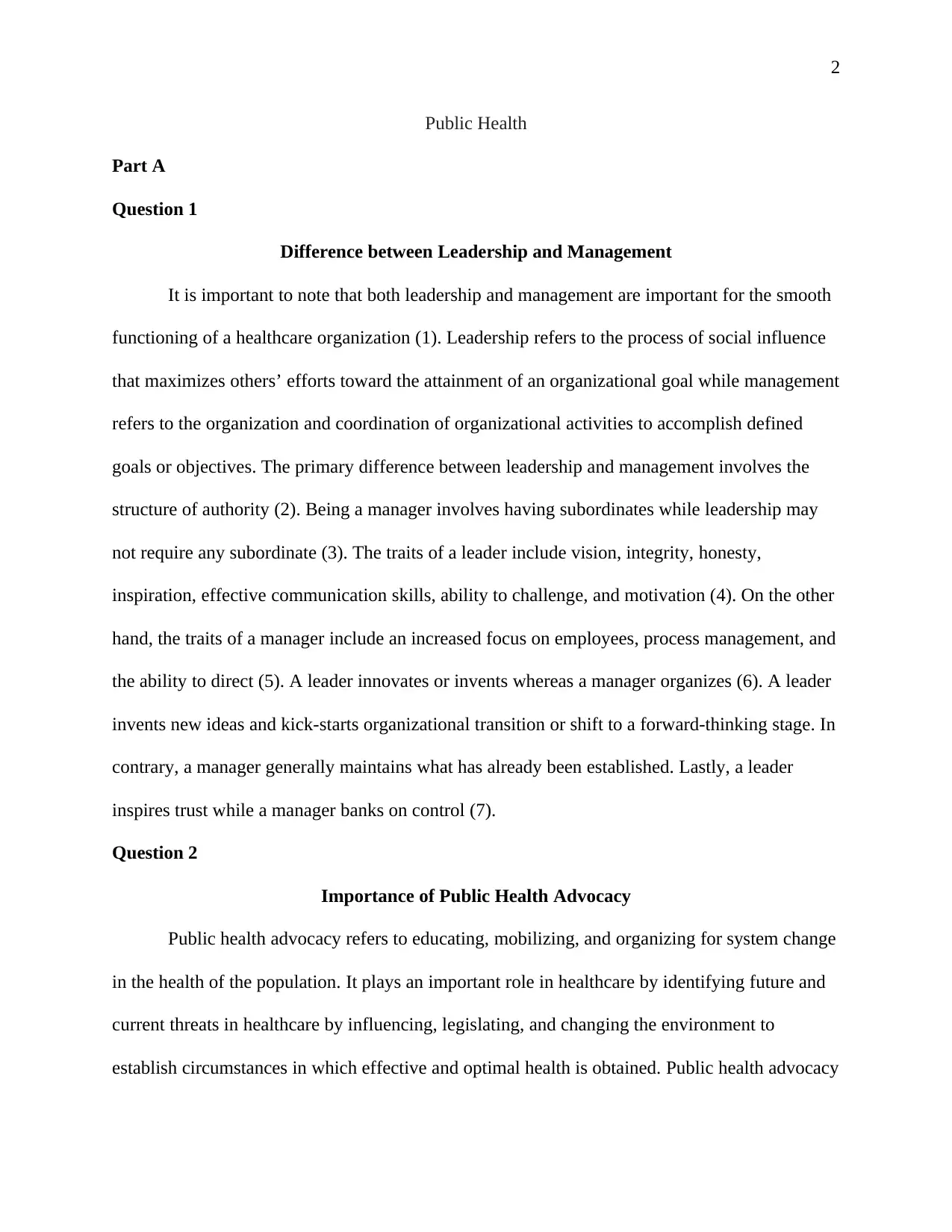
2
Public Health
Part A
Question 1
Difference between Leadership and Management
It is important to note that both leadership and management are important for the smooth
functioning of a healthcare organization (1). Leadership refers to the process of social influence
that maximizes others’ efforts toward the attainment of an organizational goal while management
refers to the organization and coordination of organizational activities to accomplish defined
goals or objectives. The primary difference between leadership and management involves the
structure of authority (2). Being a manager involves having subordinates while leadership may
not require any subordinate (3). The traits of a leader include vision, integrity, honesty,
inspiration, effective communication skills, ability to challenge, and motivation (4). On the other
hand, the traits of a manager include an increased focus on employees, process management, and
the ability to direct (5). A leader innovates or invents whereas a manager organizes (6). A leader
invents new ideas and kick-starts organizational transition or shift to a forward-thinking stage. In
contrary, a manager generally maintains what has already been established. Lastly, a leader
inspires trust while a manager banks on control (7).
Question 2
Importance of Public Health Advocacy
Public health advocacy refers to educating, mobilizing, and organizing for system change
in the health of the population. It plays an important role in healthcare by identifying future and
current threats in healthcare by influencing, legislating, and changing the environment to
establish circumstances in which effective and optimal health is obtained. Public health advocacy
Public Health
Part A
Question 1
Difference between Leadership and Management
It is important to note that both leadership and management are important for the smooth
functioning of a healthcare organization (1). Leadership refers to the process of social influence
that maximizes others’ efforts toward the attainment of an organizational goal while management
refers to the organization and coordination of organizational activities to accomplish defined
goals or objectives. The primary difference between leadership and management involves the
structure of authority (2). Being a manager involves having subordinates while leadership may
not require any subordinate (3). The traits of a leader include vision, integrity, honesty,
inspiration, effective communication skills, ability to challenge, and motivation (4). On the other
hand, the traits of a manager include an increased focus on employees, process management, and
the ability to direct (5). A leader innovates or invents whereas a manager organizes (6). A leader
invents new ideas and kick-starts organizational transition or shift to a forward-thinking stage. In
contrary, a manager generally maintains what has already been established. Lastly, a leader
inspires trust while a manager banks on control (7).
Question 2
Importance of Public Health Advocacy
Public health advocacy refers to educating, mobilizing, and organizing for system change
in the health of the population. It plays an important role in healthcare by identifying future and
current threats in healthcare by influencing, legislating, and changing the environment to
establish circumstances in which effective and optimal health is obtained. Public health advocacy
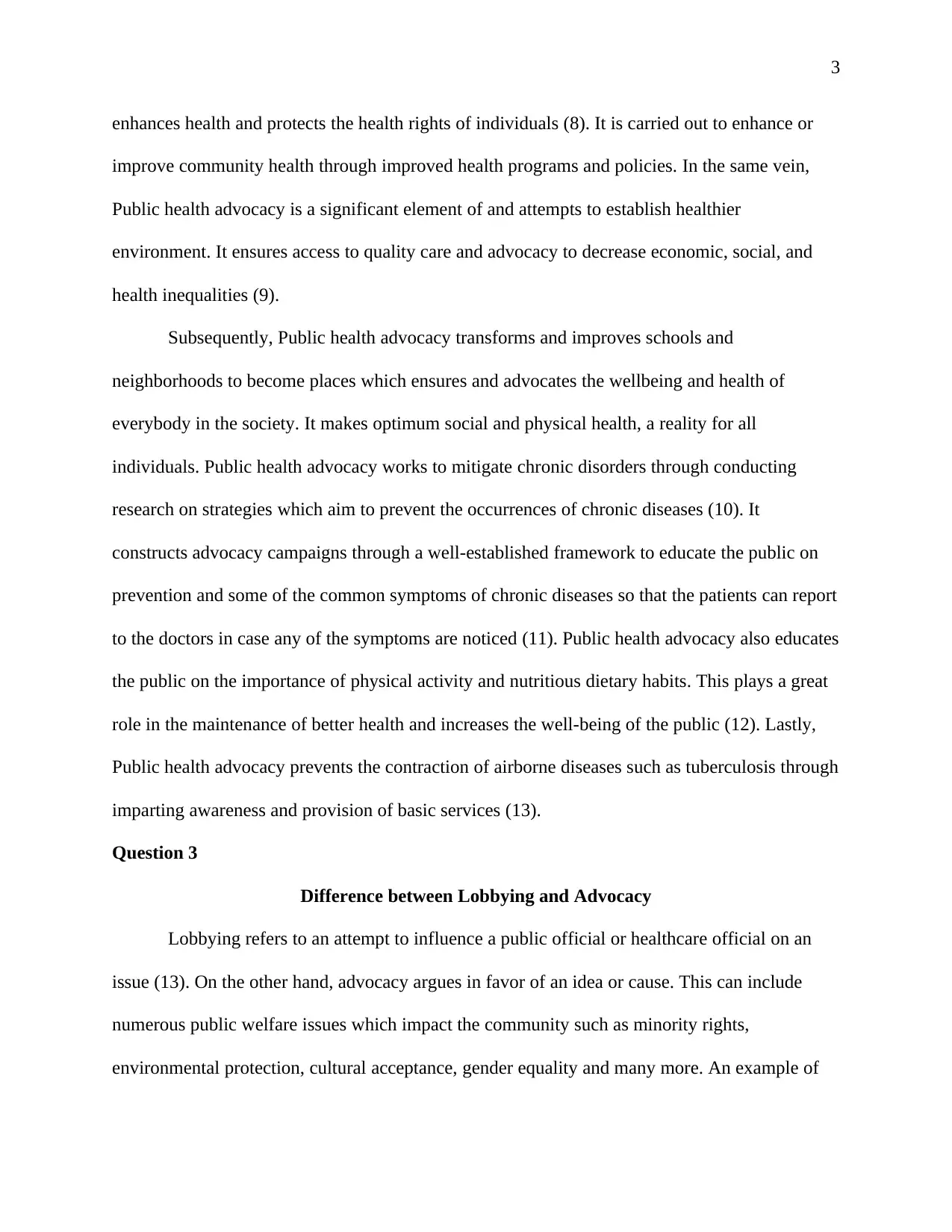
3
enhances health and protects the health rights of individuals (8). It is carried out to enhance or
improve community health through improved health programs and policies. In the same vein,
Public health advocacy is a significant element of and attempts to establish healthier
environment. It ensures access to quality care and advocacy to decrease economic, social, and
health inequalities (9).
Subsequently, Public health advocacy transforms and improves schools and
neighborhoods to become places which ensures and advocates the wellbeing and health of
everybody in the society. It makes optimum social and physical health, a reality for all
individuals. Public health advocacy works to mitigate chronic disorders through conducting
research on strategies which aim to prevent the occurrences of chronic diseases (10). It
constructs advocacy campaigns through a well-established framework to educate the public on
prevention and some of the common symptoms of chronic diseases so that the patients can report
to the doctors in case any of the symptoms are noticed (11). Public health advocacy also educates
the public on the importance of physical activity and nutritious dietary habits. This plays a great
role in the maintenance of better health and increases the well-being of the public (12). Lastly,
Public health advocacy prevents the contraction of airborne diseases such as tuberculosis through
imparting awareness and provision of basic services (13).
Question 3
Difference between Lobbying and Advocacy
Lobbying refers to an attempt to influence a public official or healthcare official on an
issue (13). On the other hand, advocacy argues in favor of an idea or cause. This can include
numerous public welfare issues which impact the community such as minority rights,
environmental protection, cultural acceptance, gender equality and many more. An example of
enhances health and protects the health rights of individuals (8). It is carried out to enhance or
improve community health through improved health programs and policies. In the same vein,
Public health advocacy is a significant element of and attempts to establish healthier
environment. It ensures access to quality care and advocacy to decrease economic, social, and
health inequalities (9).
Subsequently, Public health advocacy transforms and improves schools and
neighborhoods to become places which ensures and advocates the wellbeing and health of
everybody in the society. It makes optimum social and physical health, a reality for all
individuals. Public health advocacy works to mitigate chronic disorders through conducting
research on strategies which aim to prevent the occurrences of chronic diseases (10). It
constructs advocacy campaigns through a well-established framework to educate the public on
prevention and some of the common symptoms of chronic diseases so that the patients can report
to the doctors in case any of the symptoms are noticed (11). Public health advocacy also educates
the public on the importance of physical activity and nutritious dietary habits. This plays a great
role in the maintenance of better health and increases the well-being of the public (12). Lastly,
Public health advocacy prevents the contraction of airborne diseases such as tuberculosis through
imparting awareness and provision of basic services (13).
Question 3
Difference between Lobbying and Advocacy
Lobbying refers to an attempt to influence a public official or healthcare official on an
issue (13). On the other hand, advocacy argues in favor of an idea or cause. This can include
numerous public welfare issues which impact the community such as minority rights,
environmental protection, cultural acceptance, gender equality and many more. An example of
⊘ This is a preview!⊘
Do you want full access?
Subscribe today to unlock all pages.

Trusted by 1+ million students worldwide
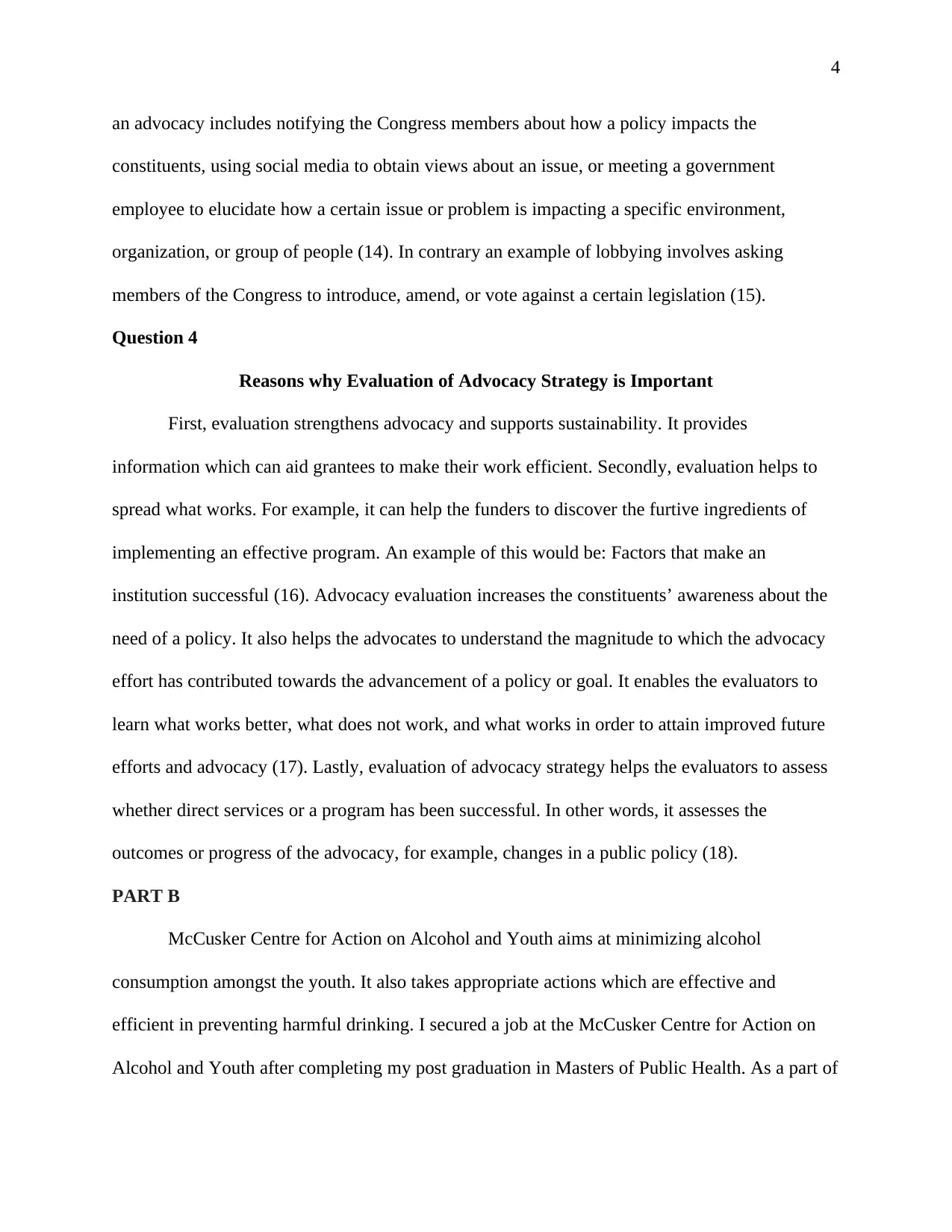
4
an advocacy includes notifying the Congress members about how a policy impacts the
constituents, using social media to obtain views about an issue, or meeting a government
employee to elucidate how a certain issue or problem is impacting a specific environment,
organization, or group of people (14). In contrary an example of lobbying involves asking
members of the Congress to introduce, amend, or vote against a certain legislation (15).
Question 4
Reasons why Evaluation of Advocacy Strategy is Important
First, evaluation strengthens advocacy and supports sustainability. It provides
information which can aid grantees to make their work efficient. Secondly, evaluation helps to
spread what works. For example, it can help the funders to discover the furtive ingredients of
implementing an effective program. An example of this would be: Factors that make an
institution successful (16). Advocacy evaluation increases the constituents’ awareness about the
need of a policy. It also helps the advocates to understand the magnitude to which the advocacy
effort has contributed towards the advancement of a policy or goal. It enables the evaluators to
learn what works better, what does not work, and what works in order to attain improved future
efforts and advocacy (17). Lastly, evaluation of advocacy strategy helps the evaluators to assess
whether direct services or a program has been successful. In other words, it assesses the
outcomes or progress of the advocacy, for example, changes in a public policy (18).
PART B
McCusker Centre for Action on Alcohol and Youth aims at minimizing alcohol
consumption amongst the youth. It also takes appropriate actions which are effective and
efficient in preventing harmful drinking. I secured a job at the McCusker Centre for Action on
Alcohol and Youth after completing my post graduation in Masters of Public Health. As a part of
an advocacy includes notifying the Congress members about how a policy impacts the
constituents, using social media to obtain views about an issue, or meeting a government
employee to elucidate how a certain issue or problem is impacting a specific environment,
organization, or group of people (14). In contrary an example of lobbying involves asking
members of the Congress to introduce, amend, or vote against a certain legislation (15).
Question 4
Reasons why Evaluation of Advocacy Strategy is Important
First, evaluation strengthens advocacy and supports sustainability. It provides
information which can aid grantees to make their work efficient. Secondly, evaluation helps to
spread what works. For example, it can help the funders to discover the furtive ingredients of
implementing an effective program. An example of this would be: Factors that make an
institution successful (16). Advocacy evaluation increases the constituents’ awareness about the
need of a policy. It also helps the advocates to understand the magnitude to which the advocacy
effort has contributed towards the advancement of a policy or goal. It enables the evaluators to
learn what works better, what does not work, and what works in order to attain improved future
efforts and advocacy (17). Lastly, evaluation of advocacy strategy helps the evaluators to assess
whether direct services or a program has been successful. In other words, it assesses the
outcomes or progress of the advocacy, for example, changes in a public policy (18).
PART B
McCusker Centre for Action on Alcohol and Youth aims at minimizing alcohol
consumption amongst the youth. It also takes appropriate actions which are effective and
efficient in preventing harmful drinking. I secured a job at the McCusker Centre for Action on
Alcohol and Youth after completing my post graduation in Masters of Public Health. As a part of
Paraphrase This Document
Need a fresh take? Get an instant paraphrase of this document with our AI Paraphraser
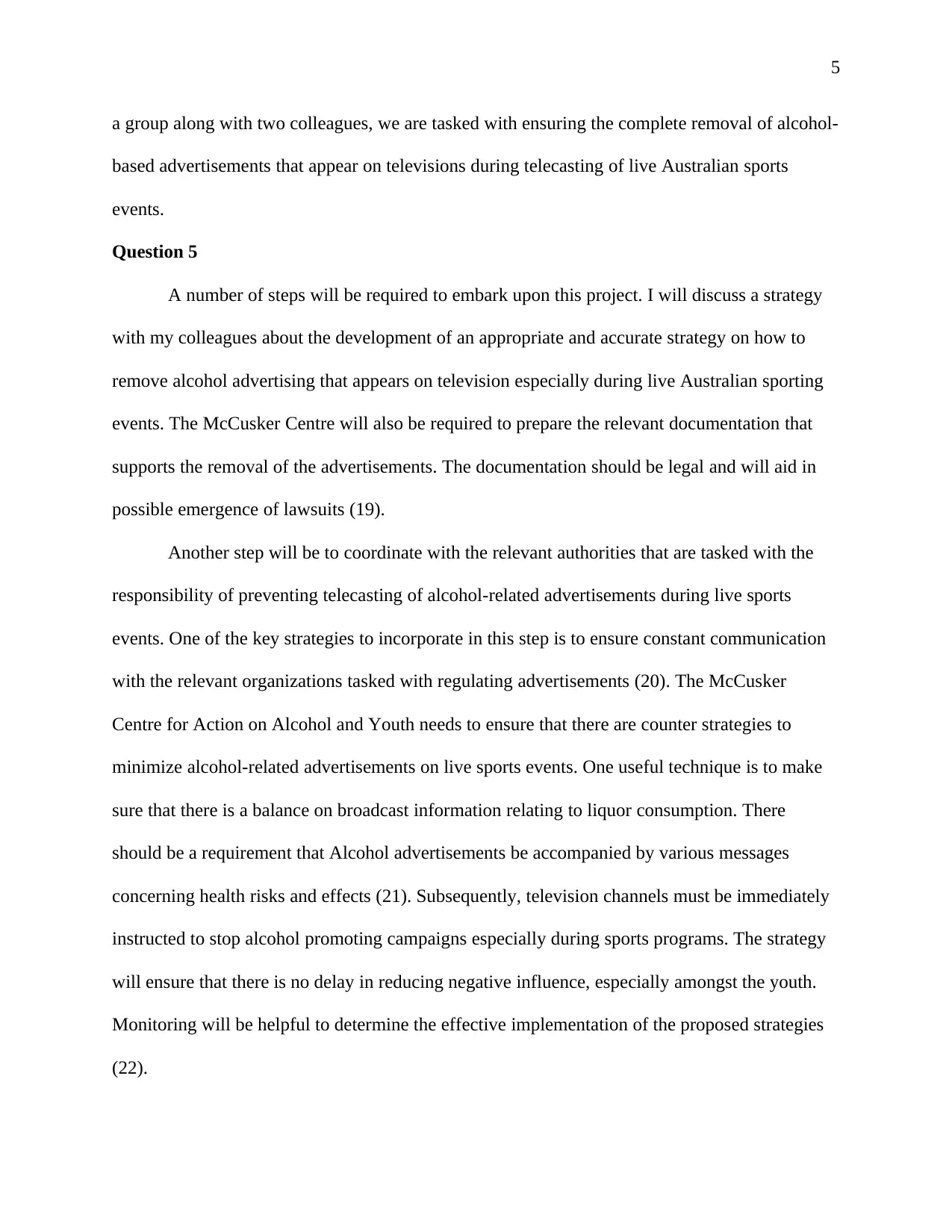
5
a group along with two colleagues, we are tasked with ensuring the complete removal of alcohol-
based advertisements that appear on televisions during telecasting of live Australian sports
events.
Question 5
A number of steps will be required to embark upon this project. I will discuss a strategy
with my colleagues about the development of an appropriate and accurate strategy on how to
remove alcohol advertising that appears on television especially during live Australian sporting
events. The McCusker Centre will also be required to prepare the relevant documentation that
supports the removal of the advertisements. The documentation should be legal and will aid in
possible emergence of lawsuits (19).
Another step will be to coordinate with the relevant authorities that are tasked with the
responsibility of preventing telecasting of alcohol-related advertisements during live sports
events. One of the key strategies to incorporate in this step is to ensure constant communication
with the relevant organizations tasked with regulating advertisements (20). The McCusker
Centre for Action on Alcohol and Youth needs to ensure that there are counter strategies to
minimize alcohol-related advertisements on live sports events. One useful technique is to make
sure that there is a balance on broadcast information relating to liquor consumption. There
should be a requirement that Alcohol advertisements be accompanied by various messages
concerning health risks and effects (21). Subsequently, television channels must be immediately
instructed to stop alcohol promoting campaigns especially during sports programs. The strategy
will ensure that there is no delay in reducing negative influence, especially amongst the youth.
Monitoring will be helpful to determine the effective implementation of the proposed strategies
(22).
a group along with two colleagues, we are tasked with ensuring the complete removal of alcohol-
based advertisements that appear on televisions during telecasting of live Australian sports
events.
Question 5
A number of steps will be required to embark upon this project. I will discuss a strategy
with my colleagues about the development of an appropriate and accurate strategy on how to
remove alcohol advertising that appears on television especially during live Australian sporting
events. The McCusker Centre will also be required to prepare the relevant documentation that
supports the removal of the advertisements. The documentation should be legal and will aid in
possible emergence of lawsuits (19).
Another step will be to coordinate with the relevant authorities that are tasked with the
responsibility of preventing telecasting of alcohol-related advertisements during live sports
events. One of the key strategies to incorporate in this step is to ensure constant communication
with the relevant organizations tasked with regulating advertisements (20). The McCusker
Centre for Action on Alcohol and Youth needs to ensure that there are counter strategies to
minimize alcohol-related advertisements on live sports events. One useful technique is to make
sure that there is a balance on broadcast information relating to liquor consumption. There
should be a requirement that Alcohol advertisements be accompanied by various messages
concerning health risks and effects (21). Subsequently, television channels must be immediately
instructed to stop alcohol promoting campaigns especially during sports programs. The strategy
will ensure that there is no delay in reducing negative influence, especially amongst the youth.
Monitoring will be helpful to determine the effective implementation of the proposed strategies
(22).
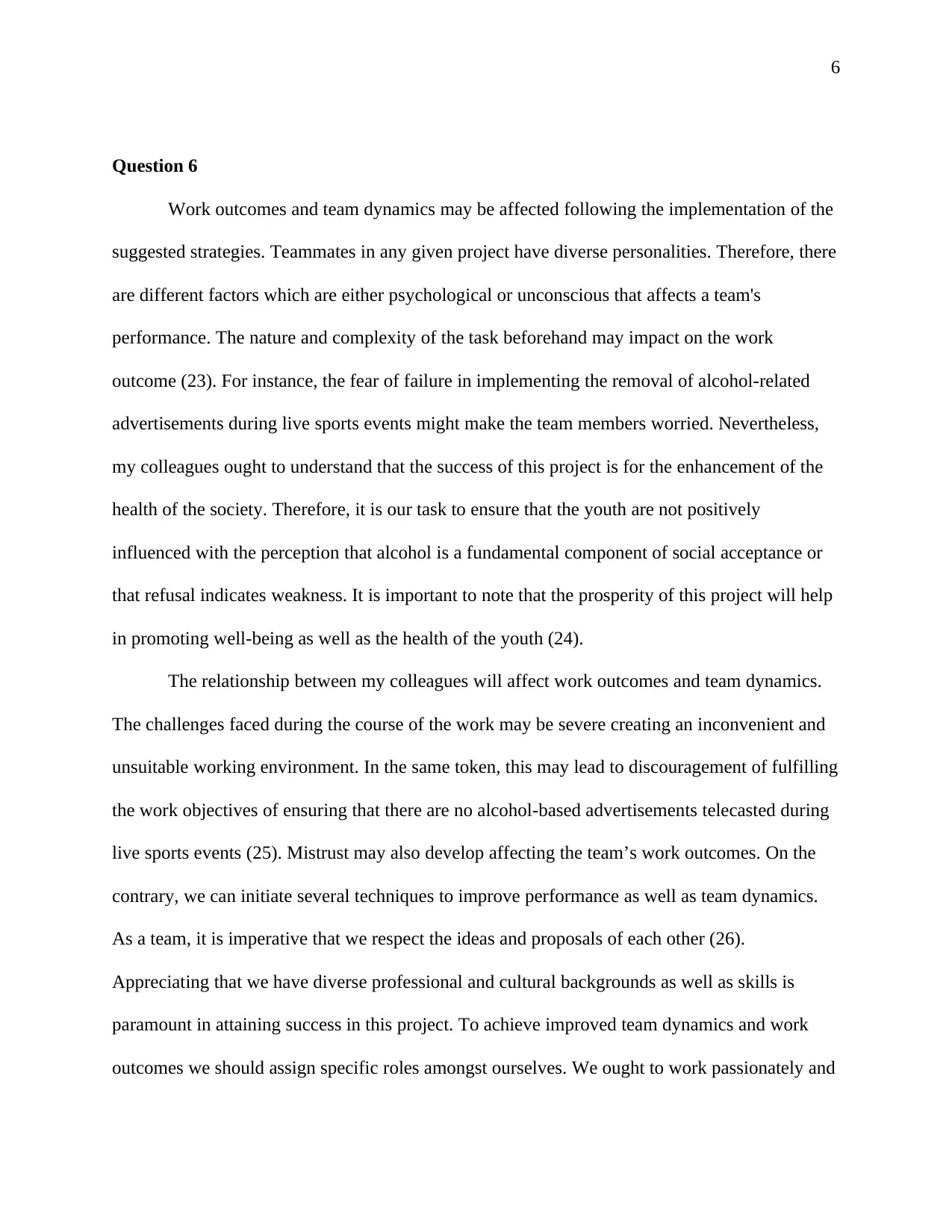
6
Question 6
Work outcomes and team dynamics may be affected following the implementation of the
suggested strategies. Teammates in any given project have diverse personalities. Therefore, there
are different factors which are either psychological or unconscious that affects a team's
performance. The nature and complexity of the task beforehand may impact on the work
outcome (23). For instance, the fear of failure in implementing the removal of alcohol-related
advertisements during live sports events might make the team members worried. Nevertheless,
my colleagues ought to understand that the success of this project is for the enhancement of the
health of the society. Therefore, it is our task to ensure that the youth are not positively
influenced with the perception that alcohol is a fundamental component of social acceptance or
that refusal indicates weakness. It is important to note that the prosperity of this project will help
in promoting well-being as well as the health of the youth (24).
The relationship between my colleagues will affect work outcomes and team dynamics.
The challenges faced during the course of the work may be severe creating an inconvenient and
unsuitable working environment. In the same token, this may lead to discouragement of fulfilling
the work objectives of ensuring that there are no alcohol-based advertisements telecasted during
live sports events (25). Mistrust may also develop affecting the team’s work outcomes. On the
contrary, we can initiate several techniques to improve performance as well as team dynamics.
As a team, it is imperative that we respect the ideas and proposals of each other (26).
Appreciating that we have diverse professional and cultural backgrounds as well as skills is
paramount in attaining success in this project. To achieve improved team dynamics and work
outcomes we should assign specific roles amongst ourselves. We ought to work passionately and
Question 6
Work outcomes and team dynamics may be affected following the implementation of the
suggested strategies. Teammates in any given project have diverse personalities. Therefore, there
are different factors which are either psychological or unconscious that affects a team's
performance. The nature and complexity of the task beforehand may impact on the work
outcome (23). For instance, the fear of failure in implementing the removal of alcohol-related
advertisements during live sports events might make the team members worried. Nevertheless,
my colleagues ought to understand that the success of this project is for the enhancement of the
health of the society. Therefore, it is our task to ensure that the youth are not positively
influenced with the perception that alcohol is a fundamental component of social acceptance or
that refusal indicates weakness. It is important to note that the prosperity of this project will help
in promoting well-being as well as the health of the youth (24).
The relationship between my colleagues will affect work outcomes and team dynamics.
The challenges faced during the course of the work may be severe creating an inconvenient and
unsuitable working environment. In the same token, this may lead to discouragement of fulfilling
the work objectives of ensuring that there are no alcohol-based advertisements telecasted during
live sports events (25). Mistrust may also develop affecting the team’s work outcomes. On the
contrary, we can initiate several techniques to improve performance as well as team dynamics.
As a team, it is imperative that we respect the ideas and proposals of each other (26).
Appreciating that we have diverse professional and cultural backgrounds as well as skills is
paramount in attaining success in this project. To achieve improved team dynamics and work
outcomes we should assign specific roles amongst ourselves. We ought to work passionately and
⊘ This is a preview!⊘
Do you want full access?
Subscribe today to unlock all pages.

Trusted by 1+ million students worldwide
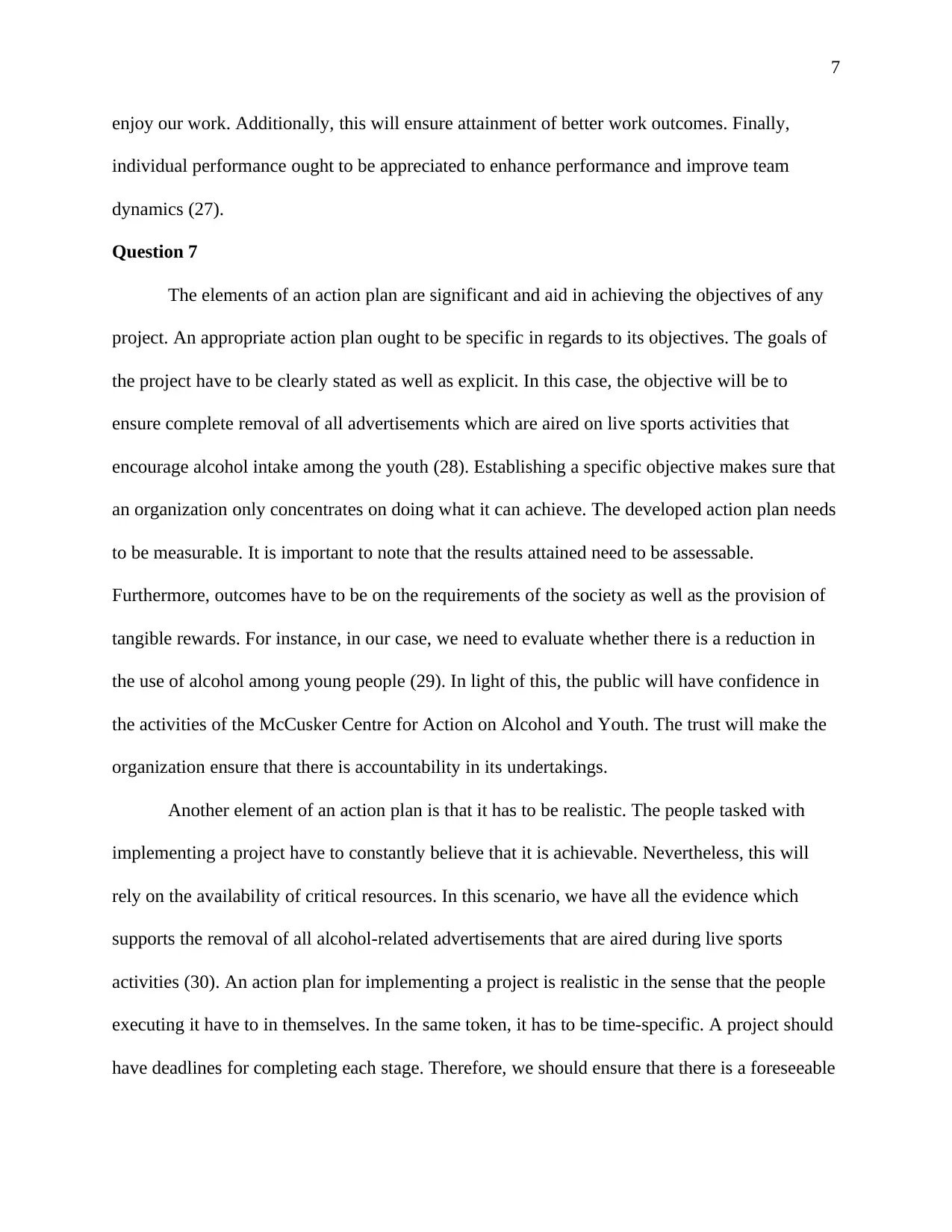
7
enjoy our work. Additionally, this will ensure attainment of better work outcomes. Finally,
individual performance ought to be appreciated to enhance performance and improve team
dynamics (27).
Question 7
The elements of an action plan are significant and aid in achieving the objectives of any
project. An appropriate action plan ought to be specific in regards to its objectives. The goals of
the project have to be clearly stated as well as explicit. In this case, the objective will be to
ensure complete removal of all advertisements which are aired on live sports activities that
encourage alcohol intake among the youth (28). Establishing a specific objective makes sure that
an organization only concentrates on doing what it can achieve. The developed action plan needs
to be measurable. It is important to note that the results attained need to be assessable.
Furthermore, outcomes have to be on the requirements of the society as well as the provision of
tangible rewards. For instance, in our case, we need to evaluate whether there is a reduction in
the use of alcohol among young people (29). In light of this, the public will have confidence in
the activities of the McCusker Centre for Action on Alcohol and Youth. The trust will make the
organization ensure that there is accountability in its undertakings.
Another element of an action plan is that it has to be realistic. The people tasked with
implementing a project have to constantly believe that it is achievable. Nevertheless, this will
rely on the availability of critical resources. In this scenario, we have all the evidence which
supports the removal of all alcohol-related advertisements that are aired during live sports
activities (30). An action plan for implementing a project is realistic in the sense that the people
executing it have to in themselves. In the same token, it has to be time-specific. A project should
have deadlines for completing each stage. Therefore, we should ensure that there is a foreseeable
enjoy our work. Additionally, this will ensure attainment of better work outcomes. Finally,
individual performance ought to be appreciated to enhance performance and improve team
dynamics (27).
Question 7
The elements of an action plan are significant and aid in achieving the objectives of any
project. An appropriate action plan ought to be specific in regards to its objectives. The goals of
the project have to be clearly stated as well as explicit. In this case, the objective will be to
ensure complete removal of all advertisements which are aired on live sports activities that
encourage alcohol intake among the youth (28). Establishing a specific objective makes sure that
an organization only concentrates on doing what it can achieve. The developed action plan needs
to be measurable. It is important to note that the results attained need to be assessable.
Furthermore, outcomes have to be on the requirements of the society as well as the provision of
tangible rewards. For instance, in our case, we need to evaluate whether there is a reduction in
the use of alcohol among young people (29). In light of this, the public will have confidence in
the activities of the McCusker Centre for Action on Alcohol and Youth. The trust will make the
organization ensure that there is accountability in its undertakings.
Another element of an action plan is that it has to be realistic. The people tasked with
implementing a project have to constantly believe that it is achievable. Nevertheless, this will
rely on the availability of critical resources. In this scenario, we have all the evidence which
supports the removal of all alcohol-related advertisements that are aired during live sports
activities (30). An action plan for implementing a project is realistic in the sense that the people
executing it have to in themselves. In the same token, it has to be time-specific. A project should
have deadlines for completing each stage. Therefore, we should ensure that there is a foreseeable
Paraphrase This Document
Need a fresh take? Get an instant paraphrase of this document with our AI Paraphraser
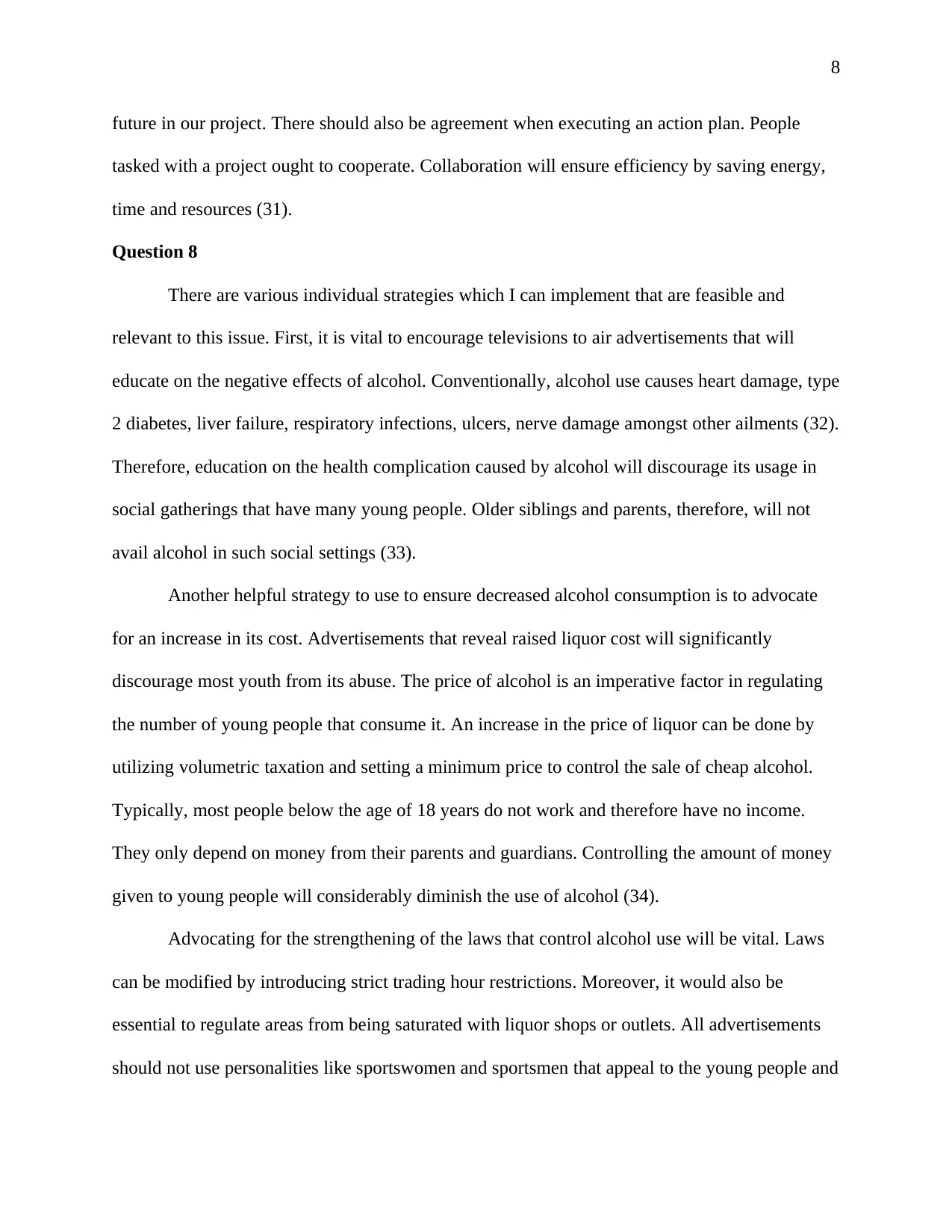
8
future in our project. There should also be agreement when executing an action plan. People
tasked with a project ought to cooperate. Collaboration will ensure efficiency by saving energy,
time and resources (31).
Question 8
There are various individual strategies which I can implement that are feasible and
relevant to this issue. First, it is vital to encourage televisions to air advertisements that will
educate on the negative effects of alcohol. Conventionally, alcohol use causes heart damage, type
2 diabetes, liver failure, respiratory infections, ulcers, nerve damage amongst other ailments (32).
Therefore, education on the health complication caused by alcohol will discourage its usage in
social gatherings that have many young people. Older siblings and parents, therefore, will not
avail alcohol in such social settings (33).
Another helpful strategy to use to ensure decreased alcohol consumption is to advocate
for an increase in its cost. Advertisements that reveal raised liquor cost will significantly
discourage most youth from its abuse. The price of alcohol is an imperative factor in regulating
the number of young people that consume it. An increase in the price of liquor can be done by
utilizing volumetric taxation and setting a minimum price to control the sale of cheap alcohol.
Typically, most people below the age of 18 years do not work and therefore have no income.
They only depend on money from their parents and guardians. Controlling the amount of money
given to young people will considerably diminish the use of alcohol (34).
Advocating for the strengthening of the laws that control alcohol use will be vital. Laws
can be modified by introducing strict trading hour restrictions. Moreover, it would also be
essential to regulate areas from being saturated with liquor shops or outlets. All advertisements
should not use personalities like sportswomen and sportsmen that appeal to the young people and
future in our project. There should also be agreement when executing an action plan. People
tasked with a project ought to cooperate. Collaboration will ensure efficiency by saving energy,
time and resources (31).
Question 8
There are various individual strategies which I can implement that are feasible and
relevant to this issue. First, it is vital to encourage televisions to air advertisements that will
educate on the negative effects of alcohol. Conventionally, alcohol use causes heart damage, type
2 diabetes, liver failure, respiratory infections, ulcers, nerve damage amongst other ailments (32).
Therefore, education on the health complication caused by alcohol will discourage its usage in
social gatherings that have many young people. Older siblings and parents, therefore, will not
avail alcohol in such social settings (33).
Another helpful strategy to use to ensure decreased alcohol consumption is to advocate
for an increase in its cost. Advertisements that reveal raised liquor cost will significantly
discourage most youth from its abuse. The price of alcohol is an imperative factor in regulating
the number of young people that consume it. An increase in the price of liquor can be done by
utilizing volumetric taxation and setting a minimum price to control the sale of cheap alcohol.
Typically, most people below the age of 18 years do not work and therefore have no income.
They only depend on money from their parents and guardians. Controlling the amount of money
given to young people will considerably diminish the use of alcohol (34).
Advocating for the strengthening of the laws that control alcohol use will be vital. Laws
can be modified by introducing strict trading hour restrictions. Moreover, it would also be
essential to regulate areas from being saturated with liquor shops or outlets. All advertisements
should not use personalities like sportswomen and sportsmen that appeal to the young people and
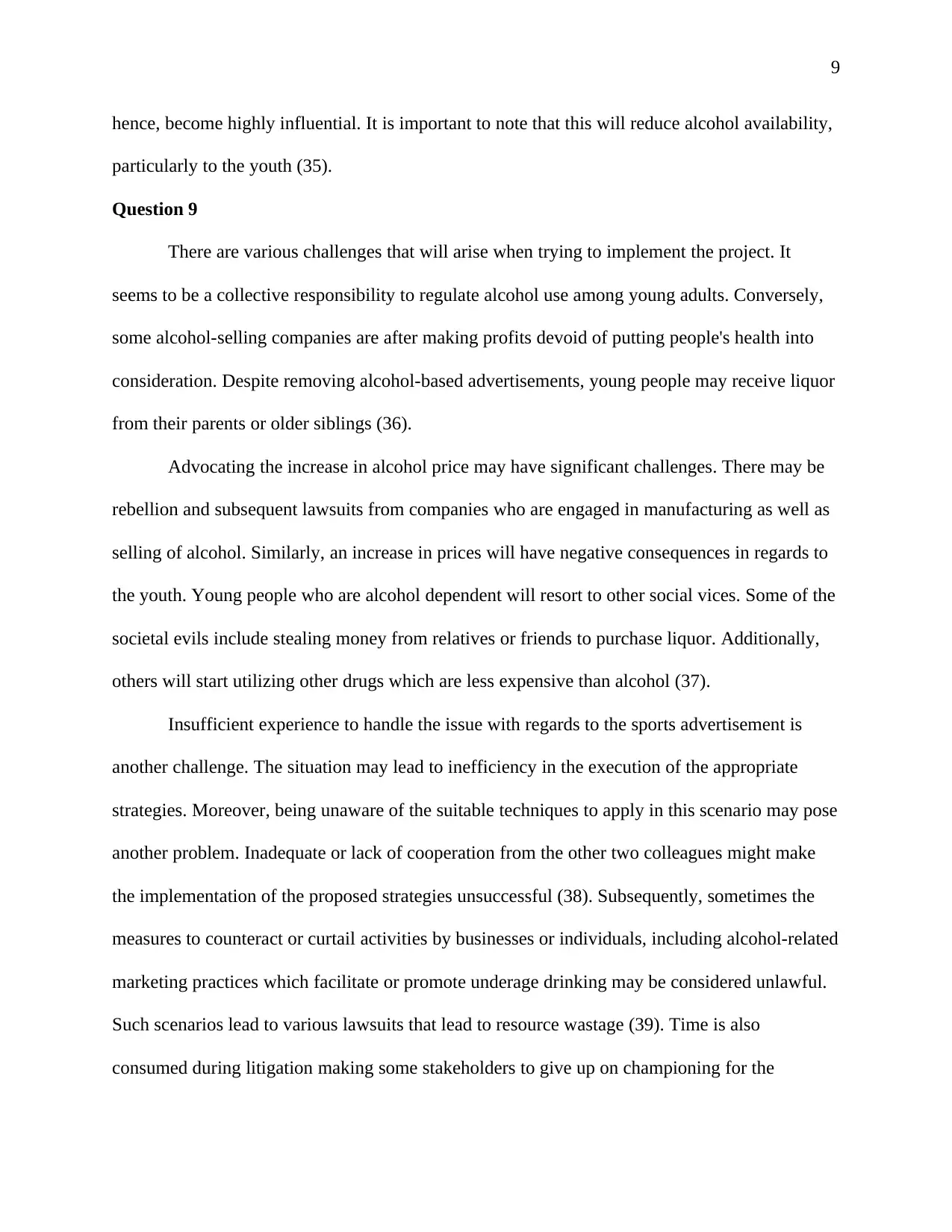
9
hence, become highly influential. It is important to note that this will reduce alcohol availability,
particularly to the youth (35).
Question 9
There are various challenges that will arise when trying to implement the project. It
seems to be a collective responsibility to regulate alcohol use among young adults. Conversely,
some alcohol-selling companies are after making profits devoid of putting people's health into
consideration. Despite removing alcohol-based advertisements, young people may receive liquor
from their parents or older siblings (36).
Advocating the increase in alcohol price may have significant challenges. There may be
rebellion and subsequent lawsuits from companies who are engaged in manufacturing as well as
selling of alcohol. Similarly, an increase in prices will have negative consequences in regards to
the youth. Young people who are alcohol dependent will resort to other social vices. Some of the
societal evils include stealing money from relatives or friends to purchase liquor. Additionally,
others will start utilizing other drugs which are less expensive than alcohol (37).
Insufficient experience to handle the issue with regards to the sports advertisement is
another challenge. The situation may lead to inefficiency in the execution of the appropriate
strategies. Moreover, being unaware of the suitable techniques to apply in this scenario may pose
another problem. Inadequate or lack of cooperation from the other two colleagues might make
the implementation of the proposed strategies unsuccessful (38). Subsequently, sometimes the
measures to counteract or curtail activities by businesses or individuals, including alcohol-related
marketing practices which facilitate or promote underage drinking may be considered unlawful.
Such scenarios lead to various lawsuits that lead to resource wastage (39). Time is also
consumed during litigation making some stakeholders to give up on championing for the
hence, become highly influential. It is important to note that this will reduce alcohol availability,
particularly to the youth (35).
Question 9
There are various challenges that will arise when trying to implement the project. It
seems to be a collective responsibility to regulate alcohol use among young adults. Conversely,
some alcohol-selling companies are after making profits devoid of putting people's health into
consideration. Despite removing alcohol-based advertisements, young people may receive liquor
from their parents or older siblings (36).
Advocating the increase in alcohol price may have significant challenges. There may be
rebellion and subsequent lawsuits from companies who are engaged in manufacturing as well as
selling of alcohol. Similarly, an increase in prices will have negative consequences in regards to
the youth. Young people who are alcohol dependent will resort to other social vices. Some of the
societal evils include stealing money from relatives or friends to purchase liquor. Additionally,
others will start utilizing other drugs which are less expensive than alcohol (37).
Insufficient experience to handle the issue with regards to the sports advertisement is
another challenge. The situation may lead to inefficiency in the execution of the appropriate
strategies. Moreover, being unaware of the suitable techniques to apply in this scenario may pose
another problem. Inadequate or lack of cooperation from the other two colleagues might make
the implementation of the proposed strategies unsuccessful (38). Subsequently, sometimes the
measures to counteract or curtail activities by businesses or individuals, including alcohol-related
marketing practices which facilitate or promote underage drinking may be considered unlawful.
Such scenarios lead to various lawsuits that lead to resource wastage (39). Time is also
consumed during litigation making some stakeholders to give up on championing for the
⊘ This is a preview!⊘
Do you want full access?
Subscribe today to unlock all pages.

Trusted by 1+ million students worldwide

10
removal of alcohol to advertisements during live sports events. Finally, the limited budget
allocated to handle the issue is a challenge. Insufficient funds make it impossible to smoothly run
activities, therefore, making work more difficult (40).
removal of alcohol to advertisements during live sports events. Finally, the limited budget
allocated to handle the issue is a challenge. Insufficient funds make it impossible to smoothly run
activities, therefore, making work more difficult (40).
Paraphrase This Document
Need a fresh take? Get an instant paraphrase of this document with our AI Paraphraser
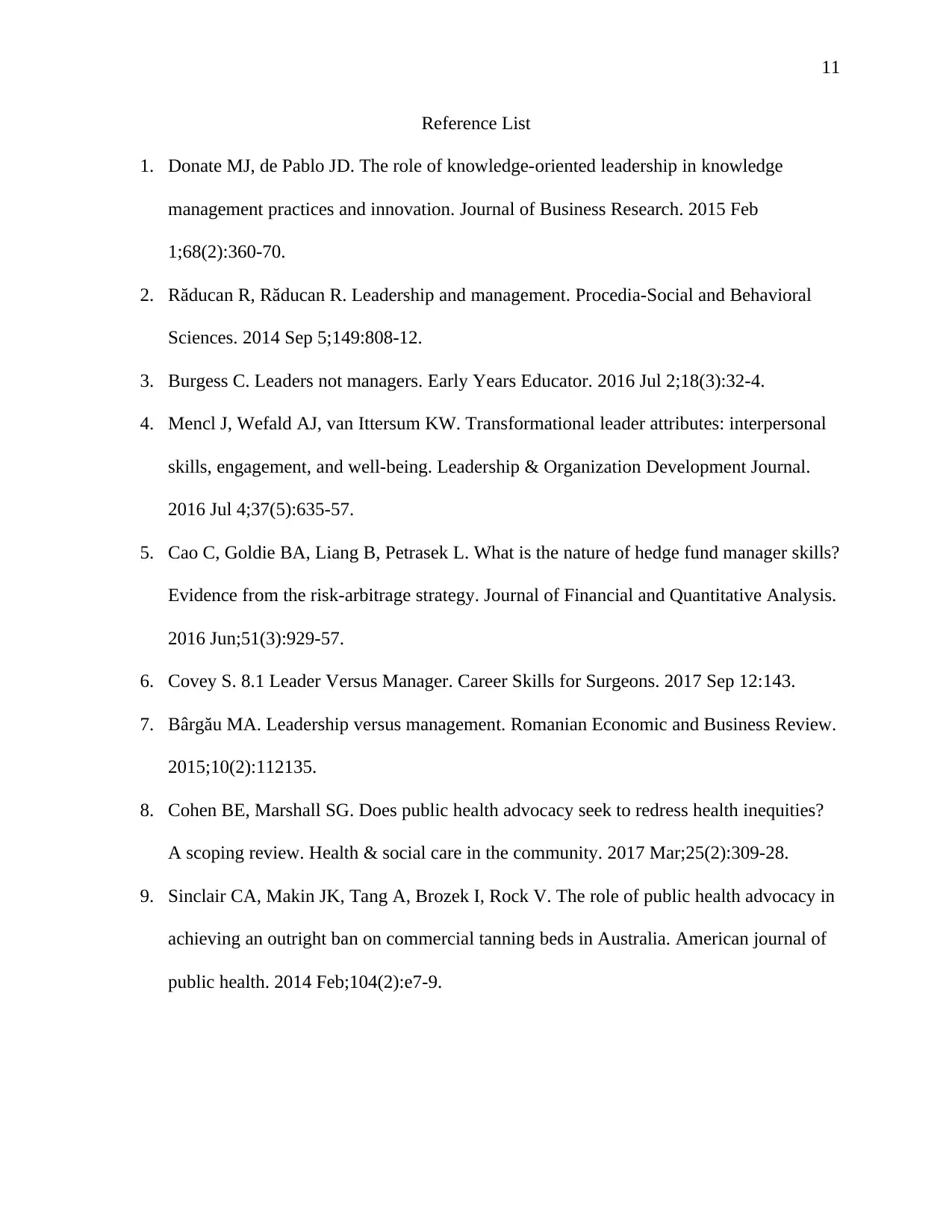
11
Reference List
1. Donate MJ, de Pablo JD. The role of knowledge-oriented leadership in knowledge
management practices and innovation. Journal of Business Research. 2015 Feb
1;68(2):360-70.
2. Răducan R, Răducan R. Leadership and management. Procedia-Social and Behavioral
Sciences. 2014 Sep 5;149:808-12.
3. Burgess C. Leaders not managers. Early Years Educator. 2016 Jul 2;18(3):32-4.
4. Mencl J, Wefald AJ, van Ittersum KW. Transformational leader attributes: interpersonal
skills, engagement, and well-being. Leadership & Organization Development Journal.
2016 Jul 4;37(5):635-57.
5. Cao C, Goldie BA, Liang B, Petrasek L. What is the nature of hedge fund manager skills?
Evidence from the risk-arbitrage strategy. Journal of Financial and Quantitative Analysis.
2016 Jun;51(3):929-57.
6. Covey S. 8.1 Leader Versus Manager. Career Skills for Surgeons. 2017 Sep 12:143.
7. Bârgău MA. Leadership versus management. Romanian Economic and Business Review.
2015;10(2):112135.
8. Cohen BE, Marshall SG. Does public health advocacy seek to redress health inequities?
A scoping review. Health & social care in the community. 2017 Mar;25(2):309-28.
9. Sinclair CA, Makin JK, Tang A, Brozek I, Rock V. The role of public health advocacy in
achieving an outright ban on commercial tanning beds in Australia. American journal of
public health. 2014 Feb;104(2):e7-9.
Reference List
1. Donate MJ, de Pablo JD. The role of knowledge-oriented leadership in knowledge
management practices and innovation. Journal of Business Research. 2015 Feb
1;68(2):360-70.
2. Răducan R, Răducan R. Leadership and management. Procedia-Social and Behavioral
Sciences. 2014 Sep 5;149:808-12.
3. Burgess C. Leaders not managers. Early Years Educator. 2016 Jul 2;18(3):32-4.
4. Mencl J, Wefald AJ, van Ittersum KW. Transformational leader attributes: interpersonal
skills, engagement, and well-being. Leadership & Organization Development Journal.
2016 Jul 4;37(5):635-57.
5. Cao C, Goldie BA, Liang B, Petrasek L. What is the nature of hedge fund manager skills?
Evidence from the risk-arbitrage strategy. Journal of Financial and Quantitative Analysis.
2016 Jun;51(3):929-57.
6. Covey S. 8.1 Leader Versus Manager. Career Skills for Surgeons. 2017 Sep 12:143.
7. Bârgău MA. Leadership versus management. Romanian Economic and Business Review.
2015;10(2):112135.
8. Cohen BE, Marshall SG. Does public health advocacy seek to redress health inequities?
A scoping review. Health & social care in the community. 2017 Mar;25(2):309-28.
9. Sinclair CA, Makin JK, Tang A, Brozek I, Rock V. The role of public health advocacy in
achieving an outright ban on commercial tanning beds in Australia. American journal of
public health. 2014 Feb;104(2):e7-9.
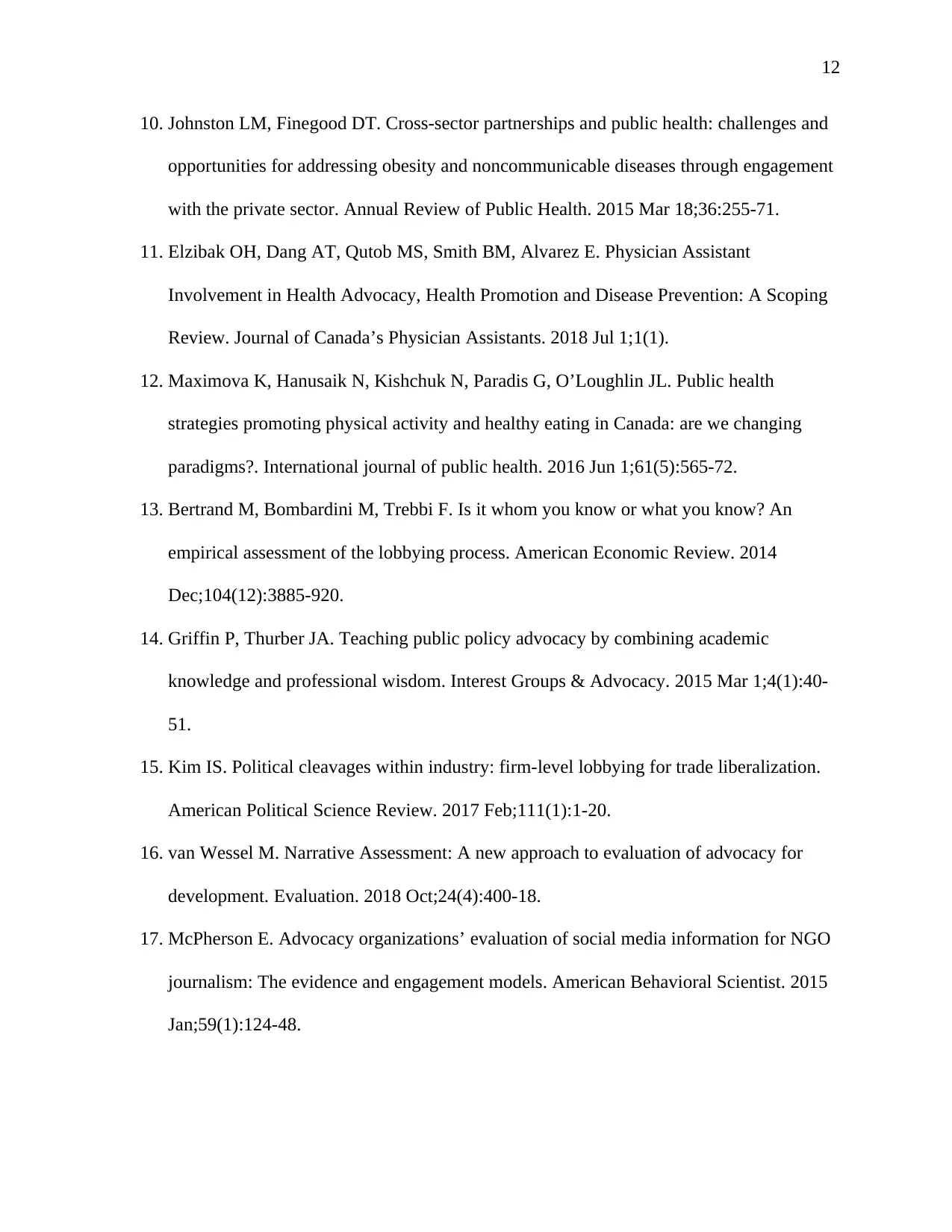
12
10. Johnston LM, Finegood DT. Cross-sector partnerships and public health: challenges and
opportunities for addressing obesity and noncommunicable diseases through engagement
with the private sector. Annual Review of Public Health. 2015 Mar 18;36:255-71.
11. Elzibak OH, Dang AT, Qutob MS, Smith BM, Alvarez E. Physician Assistant
Involvement in Health Advocacy, Health Promotion and Disease Prevention: A Scoping
Review. Journal of Canada’s Physician Assistants. 2018 Jul 1;1(1).
12. Maximova K, Hanusaik N, Kishchuk N, Paradis G, O’Loughlin JL. Public health
strategies promoting physical activity and healthy eating in Canada: are we changing
paradigms?. International journal of public health. 2016 Jun 1;61(5):565-72.
13. Bertrand M, Bombardini M, Trebbi F. Is it whom you know or what you know? An
empirical assessment of the lobbying process. American Economic Review. 2014
Dec;104(12):3885-920.
14. Griffin P, Thurber JA. Teaching public policy advocacy by combining academic
knowledge and professional wisdom. Interest Groups & Advocacy. 2015 Mar 1;4(1):40-
51.
15. Kim IS. Political cleavages within industry: firm-level lobbying for trade liberalization.
American Political Science Review. 2017 Feb;111(1):1-20.
16. van Wessel M. Narrative Assessment: A new approach to evaluation of advocacy for
development. Evaluation. 2018 Oct;24(4):400-18.
17. McPherson E. Advocacy organizations’ evaluation of social media information for NGO
journalism: The evidence and engagement models. American Behavioral Scientist. 2015
Jan;59(1):124-48.
10. Johnston LM, Finegood DT. Cross-sector partnerships and public health: challenges and
opportunities for addressing obesity and noncommunicable diseases through engagement
with the private sector. Annual Review of Public Health. 2015 Mar 18;36:255-71.
11. Elzibak OH, Dang AT, Qutob MS, Smith BM, Alvarez E. Physician Assistant
Involvement in Health Advocacy, Health Promotion and Disease Prevention: A Scoping
Review. Journal of Canada’s Physician Assistants. 2018 Jul 1;1(1).
12. Maximova K, Hanusaik N, Kishchuk N, Paradis G, O’Loughlin JL. Public health
strategies promoting physical activity and healthy eating in Canada: are we changing
paradigms?. International journal of public health. 2016 Jun 1;61(5):565-72.
13. Bertrand M, Bombardini M, Trebbi F. Is it whom you know or what you know? An
empirical assessment of the lobbying process. American Economic Review. 2014
Dec;104(12):3885-920.
14. Griffin P, Thurber JA. Teaching public policy advocacy by combining academic
knowledge and professional wisdom. Interest Groups & Advocacy. 2015 Mar 1;4(1):40-
51.
15. Kim IS. Political cleavages within industry: firm-level lobbying for trade liberalization.
American Political Science Review. 2017 Feb;111(1):1-20.
16. van Wessel M. Narrative Assessment: A new approach to evaluation of advocacy for
development. Evaluation. 2018 Oct;24(4):400-18.
17. McPherson E. Advocacy organizations’ evaluation of social media information for NGO
journalism: The evidence and engagement models. American Behavioral Scientist. 2015
Jan;59(1):124-48.
⊘ This is a preview!⊘
Do you want full access?
Subscribe today to unlock all pages.

Trusted by 1+ million students worldwide
1 out of 16
Related Documents
Your All-in-One AI-Powered Toolkit for Academic Success.
+13062052269
info@desklib.com
Available 24*7 on WhatsApp / Email
![[object Object]](/_next/static/media/star-bottom.7253800d.svg)
Unlock your academic potential
Copyright © 2020–2025 A2Z Services. All Rights Reserved. Developed and managed by ZUCOL.




